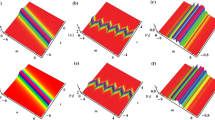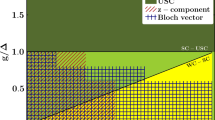Abstract
We study the evolution of qubits amplitudes in a one-dimensional chain consisting of three equidistantly spaced noninteracting qubits embedded in an open waveguide. The study is performed in the frame of single-excitation subspace, where the only qubit in the chain is initially excited. We show that the dynamics of qubits amplitudes crucially depend on the value of kd, where k is the wave vector and d is a distance between neighbor qubits. If kd is equal to an integer multiple of \(\pi \), then the qubits are excited to a stationary level. In this case, it is the dark states which prevent qubits from decaying to zero, even though they do not contribute to the output spectrum of photon emission. For other values of kd, the excitations of qubits exhibit the damping oscillations which represent the vacuum Rabi oscillations in a three-qubit system. In this case, the output spectrum of photon radiation is determined by a subradiant state which has the lowest decay rate. We also investigated the case with the frequency of a central qubit being different from that of the edge qubits. In this case, the qubits’ decay rates can be controlled by the frequency detuning between the central and the edge qubits.












Similar content being viewed by others
Data Availability Statement
The manuscript has associated data in a data repository.
References
D. Leibfried, R. Blatt, C. Monroe, D. Wineland, Quantum dynamics of single trapped ions. Rev. Mod. Phys. 75, 281 (2003)
P. Krantz, M. Kjaergaard, F. Yan, T.P. Orlando, S. Gustavsson, W.D. Oliver, A quantum engineers guide to superconducting qubits. Appl. Phys. Rev. 6, 021318 (2019)
M. Kjaergaard, M.E. Schwartz, J. Braumüller, P. Krantz, J.I.-J. Wang, S. Gustavsson, W.D. Oliver, Superconducting qubits: current state of play. Ann. Rev. Condens. Matter Phys. 11, 369 (2019)
X.L. Wang, Y.H. Luo, H.L. Huang, M.-C. Chen, Z.-E. Su, C. Liu, C. Chen, W. Li, Y.-Q. Fang, X. Jiang, J. Zhang, L. Li, N.-L. Liu, C.-Y. Lu, J.-W. Pan, 18-qubit entanglement with six photons three degrees of freedom. Phys. Rev. Lett. 120, 260502 (2018)
X.L. Wang, L.K. Chen, W. Li, H.-L. Huang, C. Liu, C. Chen, Y.-H. Luo, Z.-E. Su, D. Wu, Z.-D. Li, H. Lu, Y. Hu, X. Jiang, C.-Z. Peng, L. Li, N.-L. Liu, Y.-A. Chen, C.-Y. Lu, J.-W. Pan, Experimental ten-photon entanglement. Phys. Rev. Lett. 117, 210502 (2016)
V. Verma, D. Yadav, D.K. Mishra, Improvement on cyclic controlled teleportation by using a seven-qubit entangled state. Opt. Quantum Electron. 53, 448 (2021)
N. Samkharadze, G. Zheng, N. Kalhor, D. Brousse, A. Sammak, U.C. Mendes, A. Blais, G. Scappucci, L.M.K. Vandersypen, Strong spin-photon coupling in silicon. Science 359, 1123 (2018)
R. Khordad, H.R. Rastegar-Sedehi, Comparison of bound magneto-polaron in circular, elliptical, and triangular quantum dot qubit. Opt. Quantum Electron. 52, 428 (2020)
O. Astafiev, A.M. Zagoskin, A.A. Abdumalikov, Yu.A. Pashkin, T. Yamamoto, K. Inomata, Y. Nakamura, J.S. Tsai, Resonance fluorescence of a single artificial atom. Science 327, 840 (2010)
I.-C. Hoi, C.M. Wilson, G. Johansson, T. Palomaki, B. Peropadre, P. Delsing, Demonstration of a single-photon router in the microwave regime. Phys. Rev. Lett. 107, 073601 (2011)
A.F. van Loo, A. Fedorov, K. Lalumi’ere, B.C. Sanders, A. Blais, A. Wallra, Photon-mediated interactions between distant artificial atoms. Science 342, 1494 (2013)
D. Roy, C.M. Wilson, O. Firstenberg, Strongly interacting photons in one-dimensional continuum Rev. Mod. Phys. 89, 021001 (2017)
X. Gu, A.F. Kockum, A. Miranowicz, Y. Liu, F. Nori, Microwave photonics with superconducting quantum circuits. Phys. Rep. 718–719, 1 (2017)
S.N. Shevchenko, Mesoscopic Physics Meets Quantum Engineering (World Scientific, Singapore, 2019)
A. Albrecht, L. Henriet, A. Asenjo-Garcia, P.B. Dieterle, O. Painter, D.E. Chang, Subradiant states of quantum bits coupled to a one-dimensional waveguide. New J. Phys. 21, 025003 (2019)
Y.-X. Zhang, K. Molmer, Theory of subradiant states of a one-dimensional two-level atom chain. Phys. Rev. Lett. 122, 203605 (2019)
J. Ruostekoski, J. Javanainen, Arrays of strongly coupled atoms in a one-dimensional waveguide. Phys. Rev. A 96, 033857 (2017)
K. Lalumiere, B.C. Sanders, A.F. van Loo, A. Fedorov, A. Wallraff, A. Blais, Input-output theory for waveguide QED with an ensemble of inhomogeneous atoms. Phys. Rev. A 88, 043806 (2013)
D.E. Chang, L. Jiang, A.V. Gorshkov, H.J. Kimble, Cavity QED with atomic mirrors. New J. Phys. 14, 063003 (2012)
M. Mirhosseini, E. Kim, X. Zhang, A. Sipahigil, P.B. Dieterle, A.J. Keller, A. Asenjo-Garcia, D.E. Chang, O. Painter, Cavity quantum electrodynamics with atom-like mirrors. Nature 569, 692 (2019)
J.D. Brehm, A.N. Poddubny, A. Stehli, T. Wolz, H. Rotzinger, A.V. Ustinov, Waveguide bandgap engineering with an array of superconducting qubits. NPJ Quantum Mater. 6, 10 (2021)
A.F. van Loo, A. Fedorov, K. Lalumiere, B.C. Sanders, A. Blais, A. Wallraff, Photon-mediated interactions between distant artificial atoms. Science 342, 1494 (2014)
E. Barnes, C. Arenz, A. Pitchford, S.E. Economou, Fast microwave-driven three-qubit gates for cavity-coupled superconducting qubits. Phys. Rev. B 96, 024504 (2017)
L.T. Kenfack, M. Tchoffo, G.C. Fouokeng, L.C. Fai, Dynamical evolution of entanglement of a three-qubit system driven by a classical environmental colored noise. Quant. Inf. Process. 17, 76 (2018)
T.S. Tsoi, C.K. Law, Quantum interference effects of a single photon interacting with an atomic chain inside a one-dimensional waveguide. Phys. Rev. A 78, 063832 (2008)
Y. Zhou, Z. Zhang, Z. Yin, S. Huai, X. Gu, X. Xu, J. Allcock, F. Liu, G. Xi, Q. Yu, H. Zhang, M. Zhang, H. Li, X. Song, Z. Wang, D. Zheng, S. An, Y. Zheng, S. Zhang, Rapid and unconditional parametric reset protocol for tunable superconducting qubits. arXiv:2103.11315 [quant-ph] (2021)
P. Magnard, Ph. Kurpiers, B. Royer, T. Walter, J.-C. Besse, S. Gasparinetti, M. Pechal, J. Heinsoo, S. Storz, A. Blais, A. Wallraff, Fast and unconditional all-microwave reset of a superconducting qubit. Phys. Rev. Lett. 121, 060502 (2018)
A. Blais, R.-S. Huang, A. Wallraff, S.M. Girvin, R.J. Schoelkopf, Cavity quantum electrodynamics for superconducting electrical circuits: an architecture for quantum computation. Phys. Rev. A 69, 062320 (2004)
R.H. Lehmberg, Radiation from an N-atom system. I. General formalism. Phys. Rev. A 2, 883 (1970)
F. Keck, H.J. Korsch, S. Mossmann, Unfolding a diabolic point: a generalized crossing scenario. J. Phys. A Math. Gen. 36, 2125 (2003)
D.C. Brody, Biorthogonal quantum mechanics. J. Phys. A Math. Theor. 47, 035305 (2014)
A.P. Prudnikov, Y.A. Brychkov, O.I. Marichev, Integrals and Series. Volume 1: Elementary Functions (Gordon and Breach Science Publishers/CRC Press, New York, 1986)
Acknowledgements
Ya. S. G. thanks A. Sultanov for fruitful discussions. The work is supported by the Ministry of Education and Science of Russian Federation under the project FSUN-2020-0004.
Author information
Authors and Affiliations
Contributions
YSG wrote the manuscript and contributed to its theoretical interpretation. AAS and AGM performed computer simulations. All authors discussed the results and commented on the manuscript. The authors declare that they have no competing interests.
Appendices
Appendix A: Equations for qubits amplitudes in the Wigner–Weisskopf approximation
We assume that the first and the third qubits are identical \((\Omega _1 = \Omega _3 \equiv \Omega ,\;g_k^{(1)} = g_k^{(3)} \equiv g_k)\). The frequency and the coupling of the second qubit are different (\( \Omega _2 \equiv \Omega _0 ,\,g_k^{(2)} \equiv g_k^{(0)}\)). A distance between central qubit and the edge qubits is equal to d. We take the origin in the location of the second qubit: \(x_1= -d, x_2=0, x_3=+d\). For this case, we expand the Eq. (7) as a set of three equations
According to Wigner–Weisskopf approach, we replace \(\beta _1 (t'),\beta _2 (t'),\beta _3 (t')\) in the integrands with \(\beta _1 (t),\beta _2 (t),\beta _3 (t)\) and take them out of the integrals
where
where P.v. is a Cauchy principal value integral.
We can remove oscillating exponents in (A4)–(A6) with the aid of the substitution
In addition, we assume that the coupling constants \(g_k\) are even functions of k (\(g_k=g_{-k}\)). Then, from (A4)–(A6), we obtain
The next step is to relate the coupling constants \(g_k\) to the qubit decay rate of spontaneous emission into waveguide mode. In accordance with Fermi golden rule, we define the qubit decay rates by the following expressions:
where
D is the matrix element of the qubit’s dipole moment operator, and V is the effective volume where the interaction between qubit and electromagnetic field takes place. For 1D case, a summation over k is replaced by the integration over \(\omega \) in accordance with the prescription
where L is a length of the waveguide, and we assumed a linear dispersion law, \(\omega _k=v_gk\). The application of (A15) to, for example, (A12), allows the relation between a coupling constant \(g_k\) and the decay rate \(\Gamma \)
Therefore, we may relate the coupling constants \( g_\Omega ^{(0)} ,g_{\Omega _2 }^{(0)} , g_{\Omega _0 }^{}\) with their respective decay rates
Now, we can calculate the different terms in (A9)–(A11). We begin with the sum in the first line in (A9)
where \(\Gamma \) is given in (A12).
The second term in (A20) gives rise to the shift of the qubit frequency. Therefore, we incorporate it in the renormalized qubit frequency and will not write it explicitly any more. The sum in the second line in (A9) is calculated as follows:
For principle value integral in (A21), we obtain with a good accuracy (see Appendix B)
As is shown in Appendix B, the result (A22) is obtained by a continuation of the frequency to negative axis, the trick which lies at the mathematical background of the Wigner–Weisskopf approximation.
Therefore, we finally obtain
Similar calculations give for the last sum in (A9)
Collecting together (A20), (A23), and (A24), we write the final form of Eq. (A9)
Similar calculations for Eqs. (A10) and (A11) yield the following result:
Appendix B: Proof of Eq. (A22)
The integral
where \(a=k_\Omega d\), can be expressed in terms of sine and cosine integrals, ci and si [32]
where
The integrand in left-hand side in (B1) has a singular point at \(x=1\) which manifests itself as a singularity of Ci(a) at \(a\rightarrow 0\) in right-hand side in (B1). Therefore, we calculate integral (B1) as Cauchy principal value integral
Since
and
we obtain
The final result in (B7) is due to the known relation [32]: \( \mathop {\lim }\limits _{x \rightarrow \infty } Si(x) = \frac{\pi }{2}\).
Therefore, we finally obtain
Below, in Fig. 13, we compare the kd-dependence of (B1) with that of (B8). We see a noticeable discrepancy for \(kd<\pi /4\). For \(kd>\pi /2\), two curves are almost identical.
Rights and permissions
About this article
Cite this article
Greenberg, Y.S., Shtygashev, A.A. & Moiseev, A.G. Spontaneous decay of artificial atoms in a three-qubit system. Eur. Phys. J. B 94, 221 (2021). https://doi.org/10.1140/epjb/s10051-021-00228-2
Received:
Accepted:
Published:
DOI: https://doi.org/10.1140/epjb/s10051-021-00228-2





